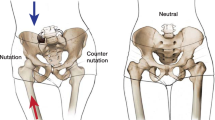Abstract
Tile C pelvic ring injuries are challenging to manage even in the most experienced hands. The majority of such injuries can be managed using percutaneous reduction techniques, and the posterior ring can be stabilized using percutaneous transiliac–transsacral screw fixation. However, a subgroup of patients present with inadequate bony corridors, significant sacral zone 2 comminution or significant lateral/vertical displacement of the hemipelvis through a complete sacral fracture. Percutaneous strategies in such circumstances can be dangerous. Those patients may benefit from prone positioning and open reduction of the sacral fracture with fixation through tension band plating or lumbo-pelvic fixation. Soft tissue handling is critical, and direct reduction techniques around the sacrum can be difficult due to the complex anatomy and the fragile nature of the sacrum making clamp placement and tightening a challenge. In this paper, we propose a mini-invasive technique of indirect reduction and temporary stabilization, which is soft tissue friendly and permits maintenance of reduction during definitive fixation surgical.




Similar content being viewed by others
References
Pohlemann T, Gänsslen A, Tscherne H (1992) The problem of the sacrum fracture. clinical analysis of 377 cases. Orthopade 21:400–412 (in German)
Beckmann N, Cai C (2017) CT characteristics of traumatic sacral fx in association with pelvic ring injuries: correlation using the Young Burgess classification system. Emerg Radiol 24:255–262
Rodrigues-Pinto R, Kurd MF et al (2017) Sacral fractures and associated injuries. Global Spine J 7(7):609–616
Tile M (1988) Pelvic ring fractures: Should they be fixed? J Bone Joint Surg Br 70:1–12
Burgess AR, Eastridge BJ, Young JW et al (1990) Pelvic ring disruptions: effective classification system and treatment protocols. J Trauma 30:848–856
Denis F, Davis S, Comfort T (1988) Sacral fractures: an important problem. Retrospective analysis of 236 cases. Clin Orthop Relat Res 227:67–81
Krappinger D, Larndorfer R, Struve P, Rosenberger R, Arora R, Blauth M (2007) Minimally invasive transiliac plate osteosynthesis for type C injuries of the pelvic ring: a clinical and radiological follow-up. J Orthop Trauma 21:595–602
Jones CB, Sietsema DL, Hoffmann MF (2012) Can lumbopelvic fixation salvage unstable complex sacral fractures? Clin Orthop Relat Res 470:2132–2141
Hak DJ, Baran S, Stahel P (2009) Sacral fractures: current strategies in diagnosis and management. Orthopedics 32:752–757
Ruatti S, Kerschbaumer G, Gay E et al (2013) Technique for reduction and percutaneous fixation of U- and H- sacral fractures. Orthop Traumatol Surg Res 99:625–629
König MA, Seidel U, Heini P et al (2013) Minimal-invasive percutaneous reduction and transsacral screw fixation for U-shaped fractures. J Spinal Disord Tech 26:48–54
Bottlang M, Schemitsch CE, Nauth A, Routt M et al (2015) Biomechanical concepts for fracture fixation. J Orthop Trauma 29(0 12):S28–S33
Sullivan MP, Scolaro JA, Milby AH, Mehta S (2015) Isolated pelvic ring injuries: functional outcomes following percutaneous, posterior fixation. Eur J Orthop Surg Traumatol 25:1025–1030
Routt MC Jr, Simonian PT, Mills WJ (1997) Iliosacral screw fixation: early complications of the percutaneous technique. J Orthop Trauma 11(8):584–589
Ayoub MA (2012) Type C pelvic ring injuries in polytrauma patients: Can percutaneous iliosacral screws reduce morbidity and costs? Eur J Orthop Surg Traumatol 22(2):137–144
Kim JW, Oh CW, Oh JK, Kyung HS, Park KH, Yoon SD, Yoon SH (2016) The incidence of and factors affecting iliosacral screw loosening in pelvic ring injury. Arch Orthop Trauma Surg 136(7):921–927
Author information
Authors and Affiliations
Corresponding author
Ethics declarations
Conflict of interest
All authors declares that there is no conflict of interest
Electronic supplementary material
Below is the link to the electronic supplementary material.
Rights and permissions
About this article
Cite this article
Martin, M.P., Rojas, D. & Mauffrey, C. Reduction and temporary stabilization of Tile C pelvic ring injuries using a posteriorly based external fixation system. Eur J Orthop Surg Traumatol 28, 893–898 (2018). https://doi.org/10.1007/s00590-017-2104-8
Received:
Accepted:
Published:
Issue Date:
DOI: https://doi.org/10.1007/s00590-017-2104-8




